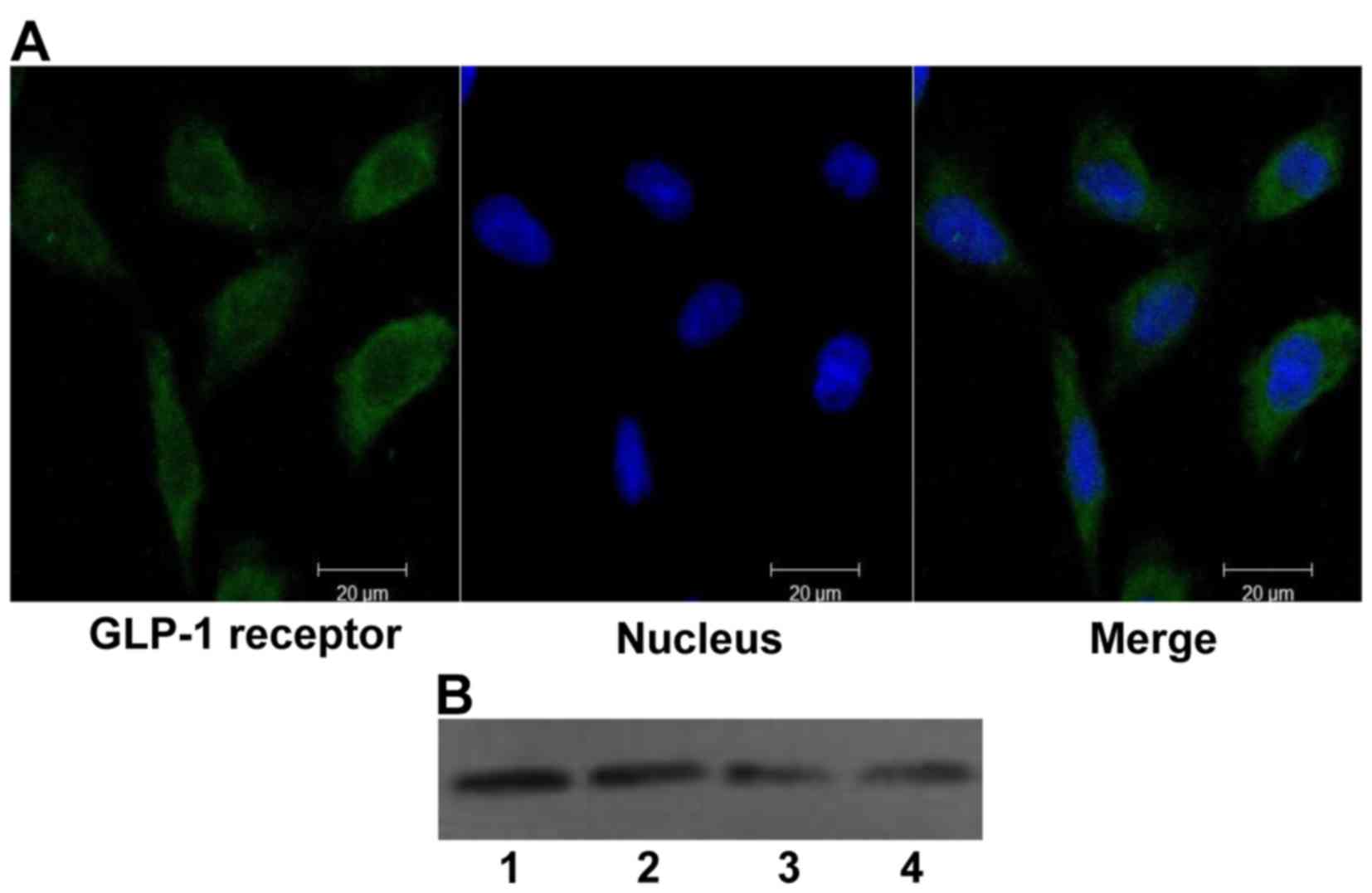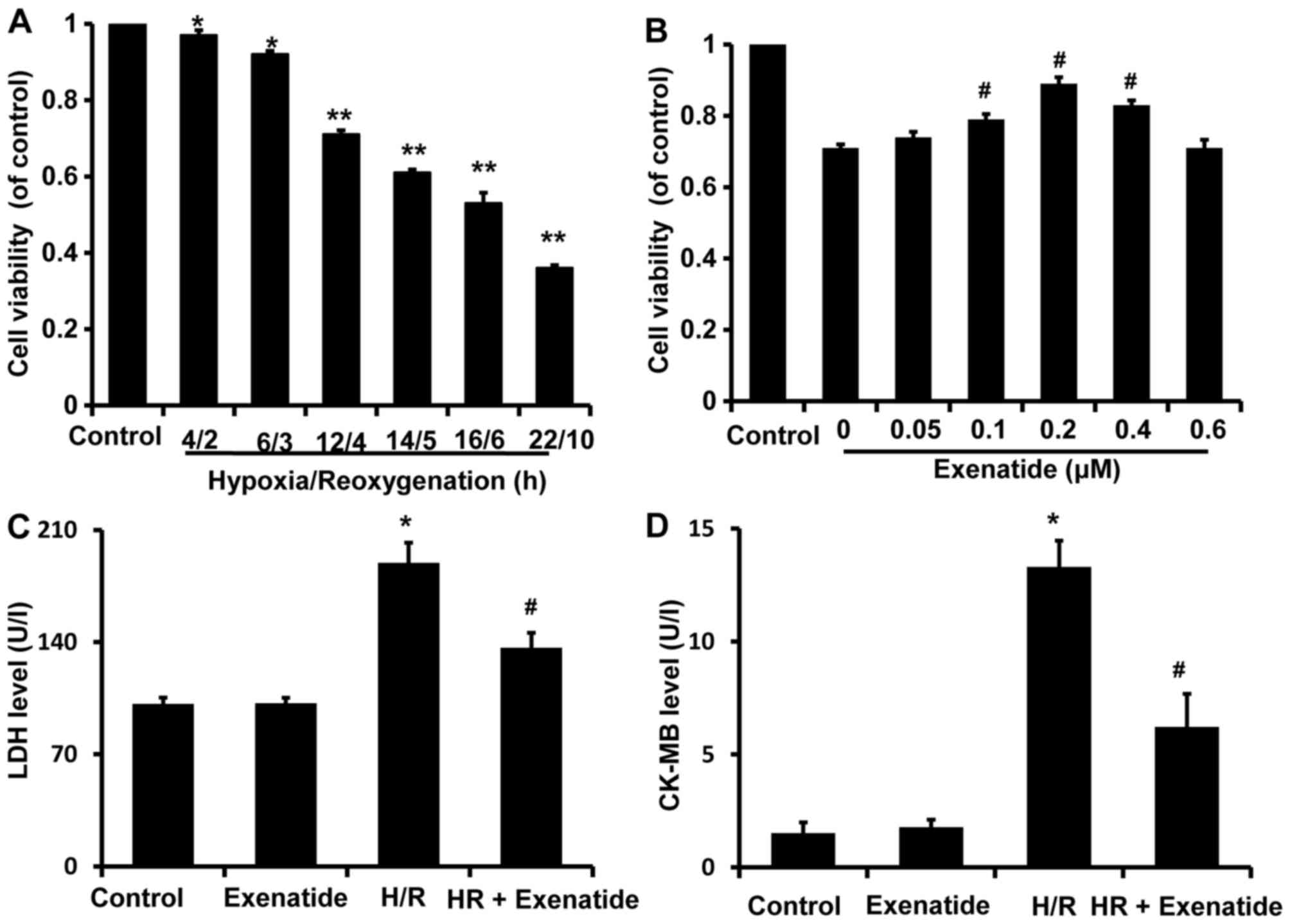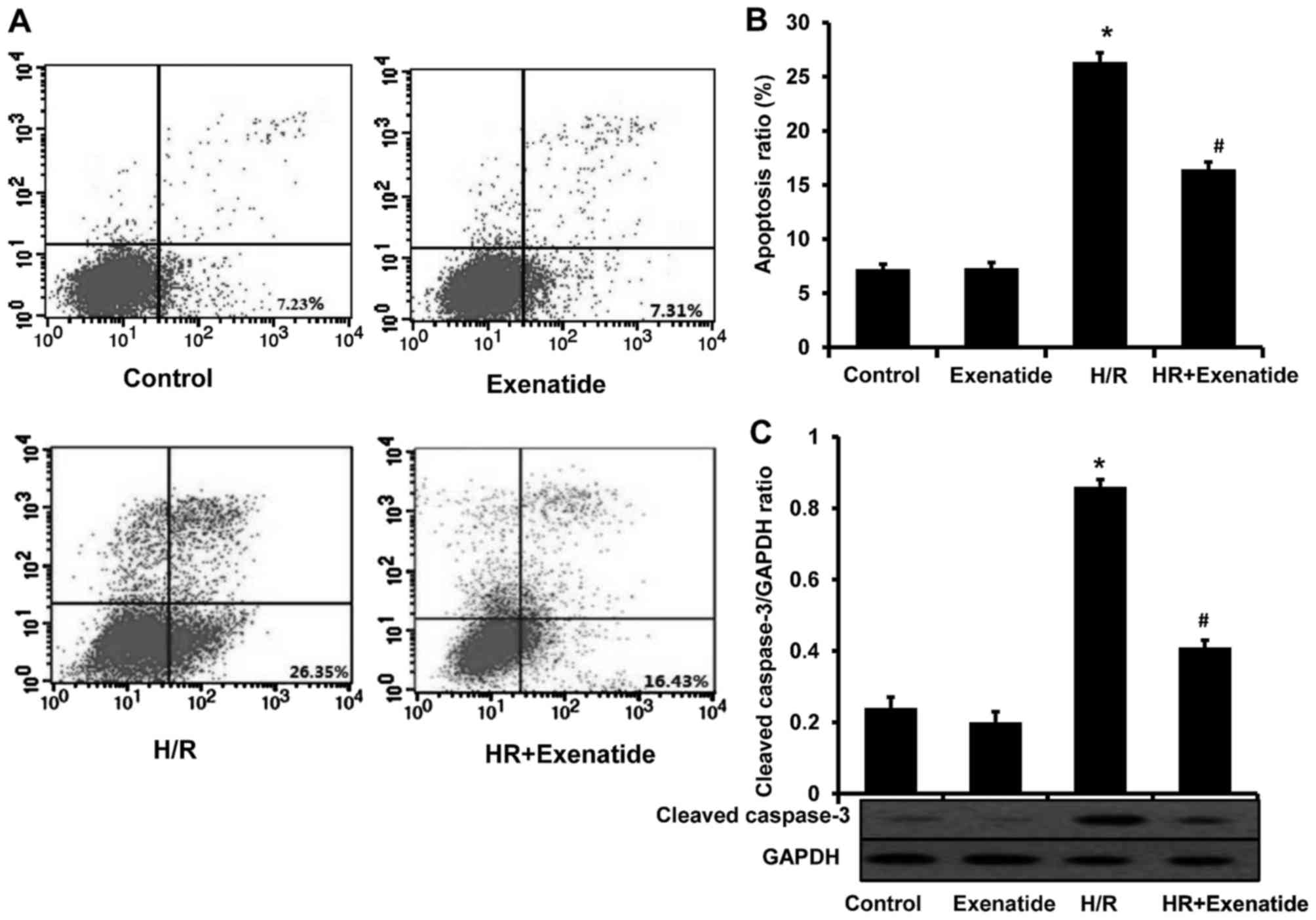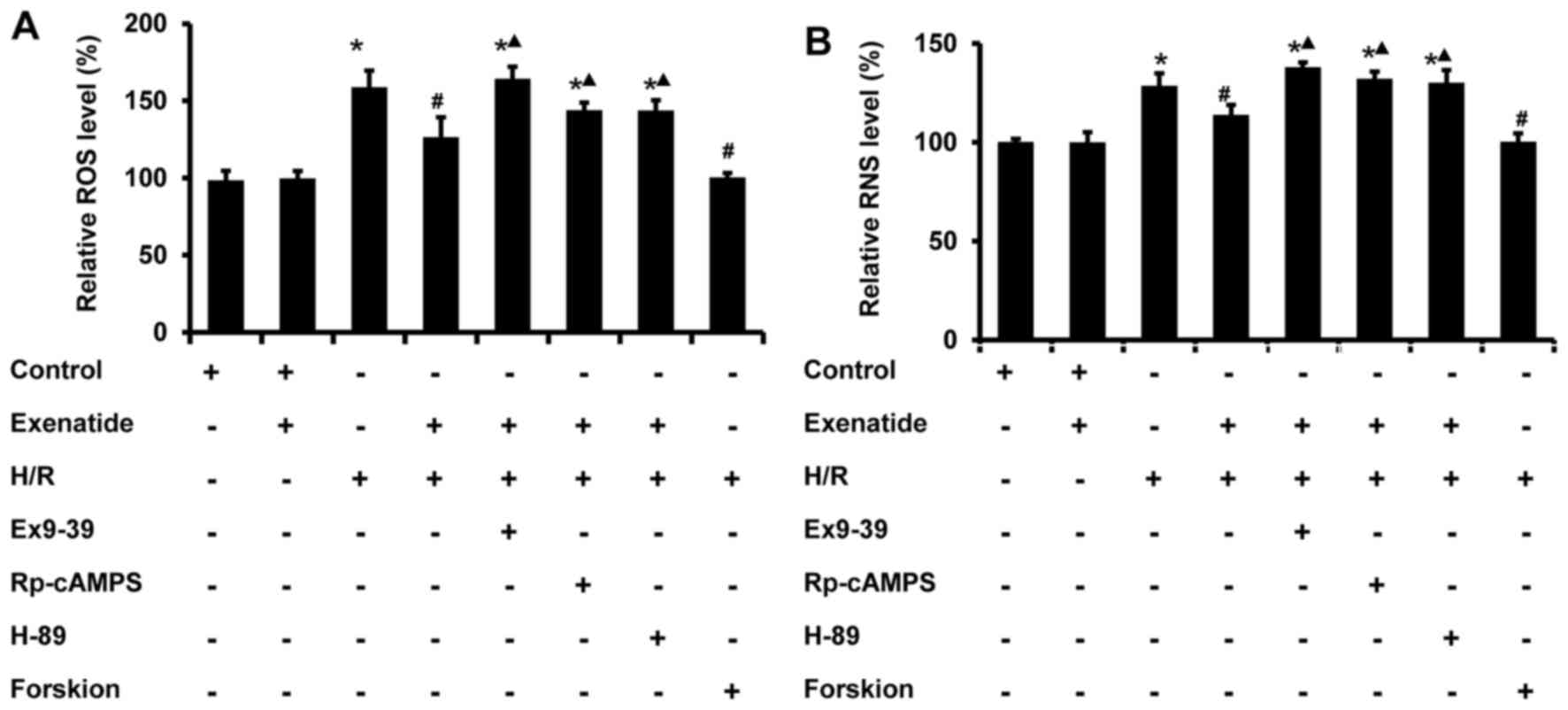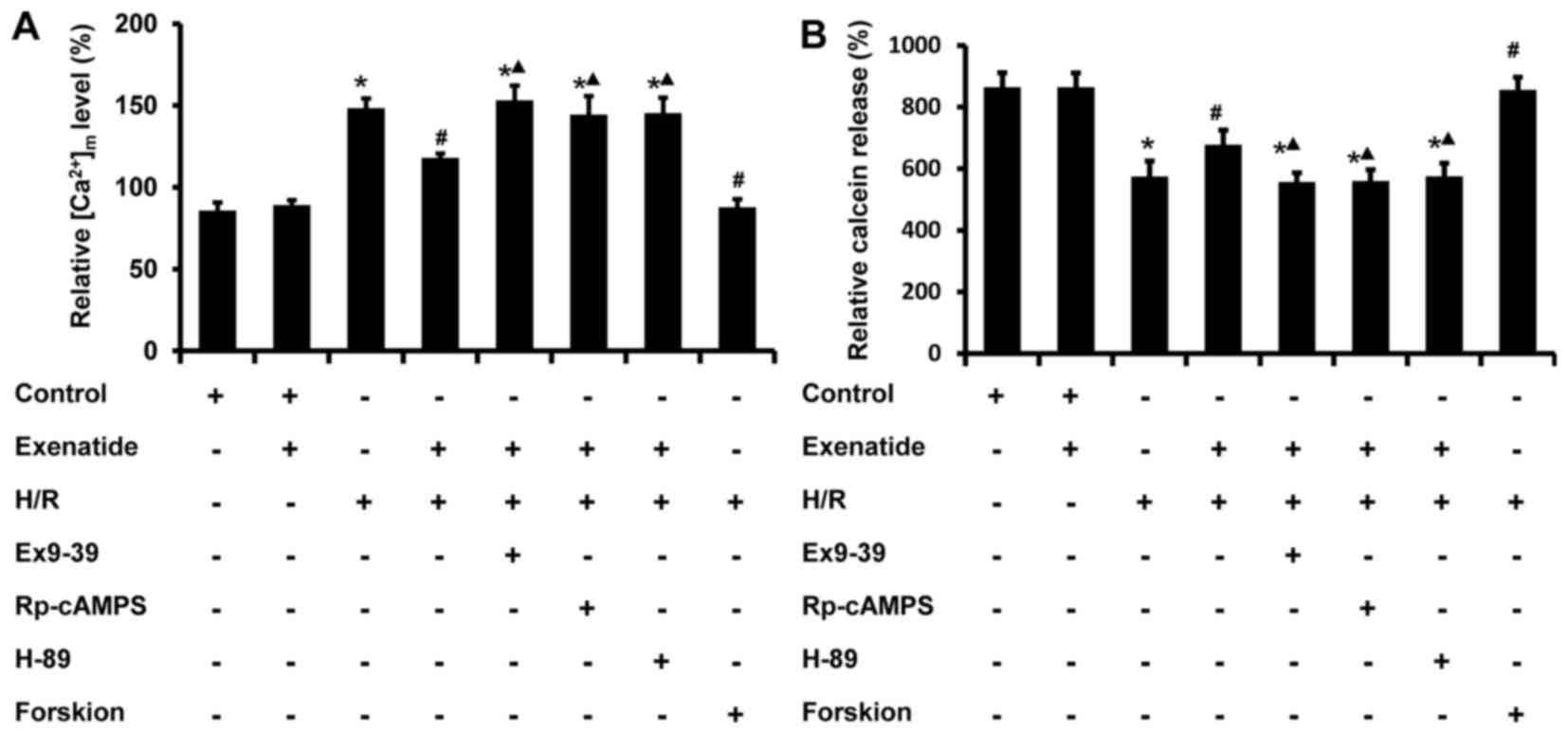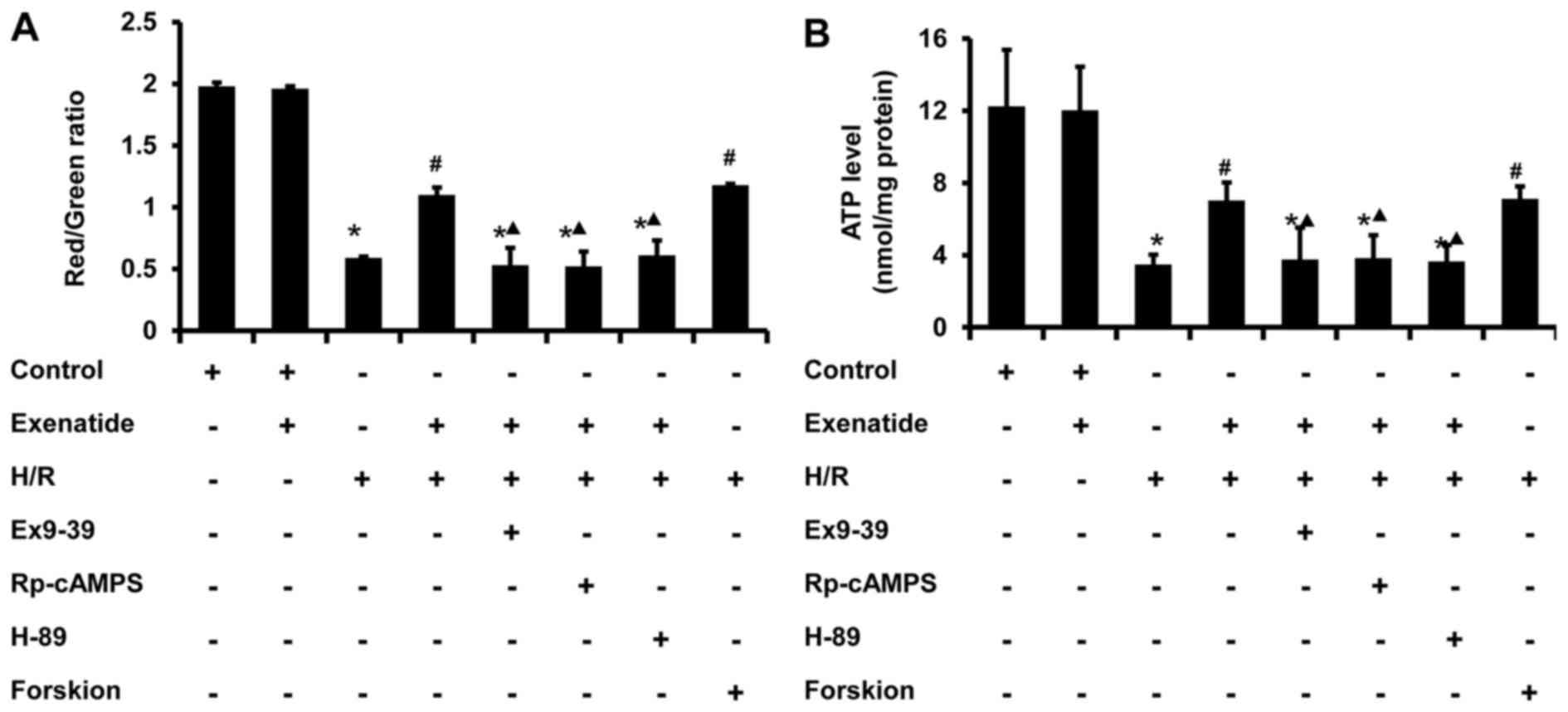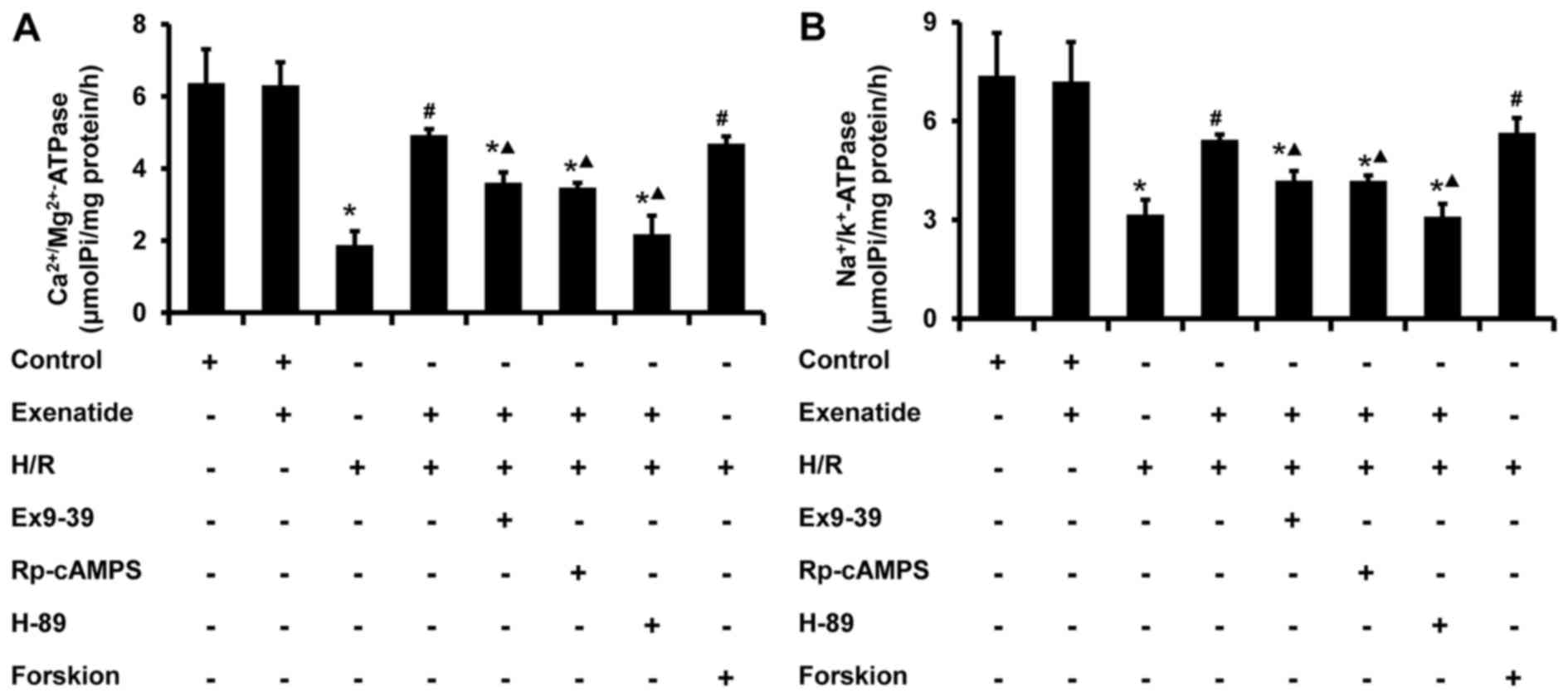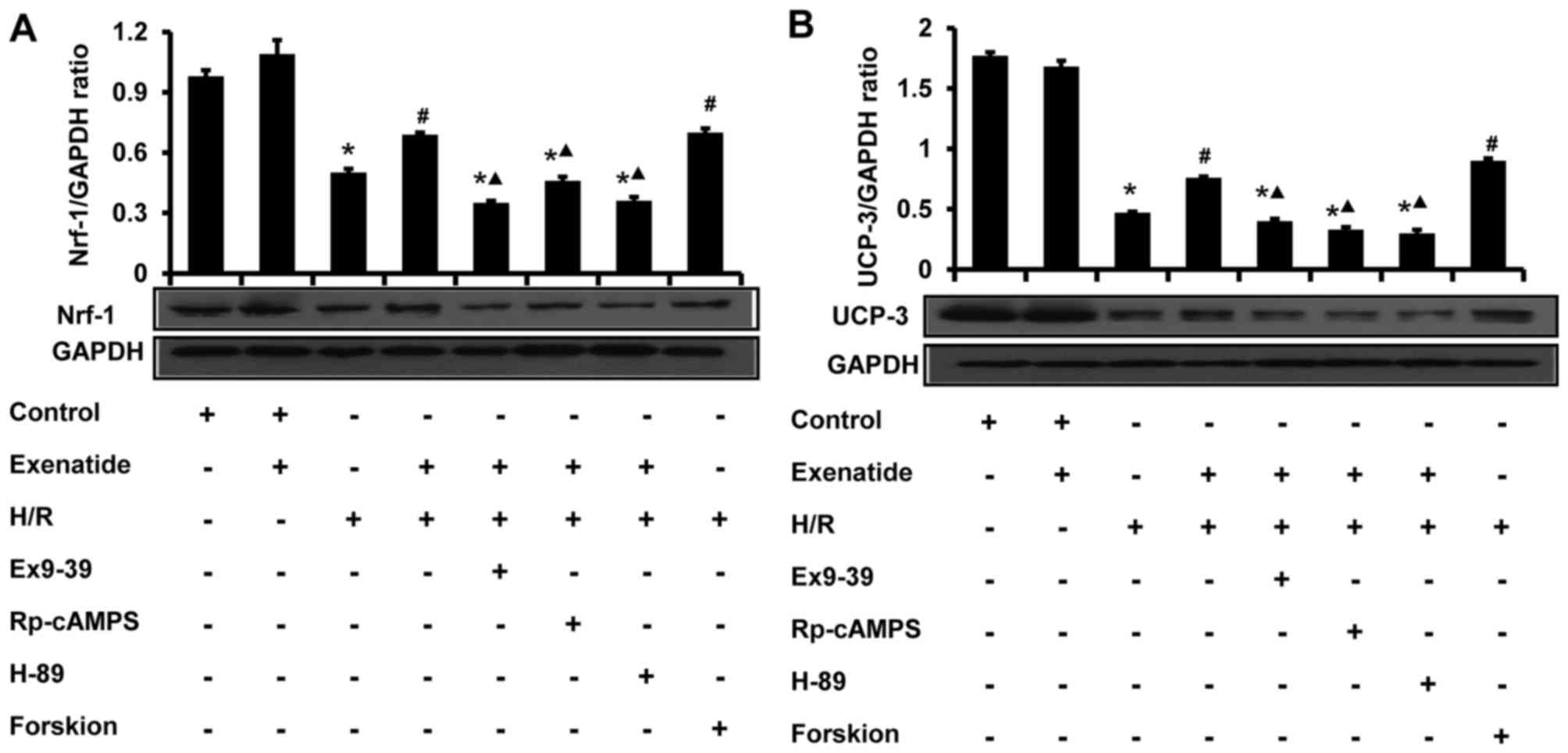|
1
|
Braunwald E and Kloner RA: Myocardial
reperfusion: A double-edged sword? J Clin Invest. 76:1713–1719.
1985. View Article : Google Scholar : PubMed/NCBI
|
|
2
|
Acar E, Ural D, Bildirici U, Sahin T and
Yılmaz I: Diabetic cardiomyopathy. Anadolu Kardiyol Derg.
11:732–737. 2011.PubMed/NCBI
|
|
3
|
Ong SB and Gustafsson AB: New roles for
mitochondria in cell death in the reperfused myocardium. Cardiovasc
Res. 94:190–196. 2012. View Article : Google Scholar :
|
|
4
|
Honda HM, Korge P and Weiss JN:
Mitochondria and ischemia/reperfusion injury. Ann NY Acad Sci.
1047:248–258. 2005. View Article : Google Scholar : PubMed/NCBI
|
|
5
|
Lesnefsky EJ and Hoppel CL:
Ischemia-reperfusion injury in the aged heart: Role of
mitochondria. Arch Biochem Biophys. 420:287–297. 2003. View Article : Google Scholar : PubMed/NCBI
|
|
6
|
Sun L, Zhao M, Yu XJ, Wang H, He X, Liu JK
and Zang WJ: Cardioprotection by acetylcholine: A novel mechanism
via mitochondrial biogenesis and function involving the PGC-1α
pathway. J Cell Physiol. 228:1238–1248. 2013. View Article : Google Scholar
|
|
7
|
Yue R, Hu H, Yiu KH, Luo T, Zhou Z, Xu L,
Zhang S, Li K and Yu Z: Lycopene protects against
hypoxia/reoxygenation-induced apoptosis by preventing mitochondrial
dysfunction in primary neonatal mouse cardiomyocytes. PLoS One.
7:e507782012. View Article : Google Scholar : PubMed/NCBI
|
|
8
|
Rehman H, Shi Y and Zhong Z:
Ischemia/reperfusion inhibits mitochondrial biogenesis after
partial hepatectomy in mice: 1738. Transplantation. 90:8392010.
View Article : Google Scholar
|
|
9
|
Ren J, Pulakat L, Whaley-Connell A and
Sowers JR: Mitochondrial biogenesis in the metabolic syndrome and
cardiovascular disease. J Mol Med (Berl). 88:993–1001. 2010.
View Article : Google Scholar
|
|
10
|
Rimbaud S, Garnier A and Ventura-Clapier
R: Mitochondrial biogenesis in cardiac pathophysiology. Pharmacol
Rep. 61:131–138. 2009. View Article : Google Scholar : PubMed/NCBI
|
|
11
|
Garber AJ: Novel GLP-1 receptor agonists
for diabetes. Expert Opin Investig Drugs. 21:45–57. 2012.
View Article : Google Scholar
|
|
12
|
Mundil D, Cameron-Vendrig A and Husain M:
GLP-1 receptor agonists: A clinical perspective on cardiovascular
effects. Diab Vasc Dis Res. 9:95–108. 2012. View Article : Google Scholar : PubMed/NCBI
|
|
13
|
Baggio LL and Drucker DJ: Biology of
incretins: GLP-1 and GIP. Gastroenterology. 132:2131–2157. 2007.
View Article : Google Scholar : PubMed/NCBI
|
|
14
|
Wei Y and Mojsov S: Tissue-specific
expression of the human receptor for glucagon-like peptide-I:
Brain, heart and pancreatic forms have the same deduced amino acid
sequences. FEBS Lett. 358:219–224. 1995. View Article : Google Scholar : PubMed/NCBI
|
|
15
|
Chinda K, Chattipakorn S and Chattipakorn
N: Cardioprotective effects of incretin during
ischaemia-reperfusion. Diab Vasc Dis Res. 9:256–269. 2012.
View Article : Google Scholar : PubMed/NCBI
|
|
16
|
Ravassa S, Zudaire A and Díez J: GLP-1 and
cardioprotection: From bench to bedside. Cardiovasc Res.
94:316–323. 2012. View Article : Google Scholar : PubMed/NCBI
|
|
17
|
Bao W, Holt LJ, Prince RD, Jones GX,
Aravindhan K, Szapacs M, Barbour AM, Jolivette LJ, Lepore JJ,
Willette RN, et al: Novel fusion of GLP-1 with a domain antibody to
serum albumin prolongs protection against myocardial
ischemia/reperfusion injury in the rat. Cardiovasc Diabetol.
12:1482013. View Article : Google Scholar : PubMed/NCBI
|
|
18
|
Zhao TC: Glucagon-like peptide-1 (GLP-1)
and protective effects in cardiovascular disease: A new therapeutic
approach for myocardial protection. Cardiovasc Diabetol. 12:902013.
View Article : Google Scholar : PubMed/NCBI
|
|
19
|
Liu Q, Anderson C, Broyde A, Polizzi C,
Fernandez R, Baron A and Parkes DG: Glucagon-like peptide-1 and the
exenatide analogue AC3174 improve cardiac function, cardiac
remodeling, and survival in rats with chronic heart failure.
Cardiovasc Diabetol. 9:762010. View Article : Google Scholar : PubMed/NCBI
|
|
20
|
Brown SB, Libonati JR, Selak MA, Shannon
RP and Simmons RA: Neonatal exendin-4 leads to protection from
reperfusion injury and reduced rates of oxidative phosphorylation
in the adult rat heart. Cardiovasc Drugs Ther. 24:197–205. 2010.
View Article : Google Scholar : PubMed/NCBI
|
|
21
|
Tomas E, Stanojevic V and Habener JF:
GLP-1-derived nonapeptide GLP-1(28-36)amide targets to mitochondria
and suppresses glucose production and oxidative stress in isolated
mouse hepatocytes. Regul Pept. 167:177–184. 2011. View Article : Google Scholar : PubMed/NCBI
|
|
22
|
Park M, Youn B, Zheng XL, Wu D, Xu A and
Sweeney G: Globular adiponectin, acting via AdipoR1/APPL1, protects
H9c2 cells from hypoxia/reoxygenation-induced apoptosis. PLoS One.
6:e191432011. View Article : Google Scholar : PubMed/NCBI
|
|
23
|
Wang L, Wang ZH, Shen CY, You ML, Xiao JF
and Chen GQ: Differentiation of human bone marrow mesenchymal stem
cells grown in terpolyesters of 3-hydroxyalkanoates scaffolds into
nerve cells. Biomaterials. 31:1691–1698. 2010. View Article : Google Scholar
|
|
24
|
Kumar S, Kain V and Sitasawad SL: High
glucose-induced Ca2þ overload and oxidative stress contribute to
apoptosis of cardiac cells through mitochondrial dependent and
independent pathways. Biochim Biophys Acta. 1820:907–920. 2012.
View Article : Google Scholar : PubMed/NCBI
|
|
25
|
Odagiri K, Katoh H, Kawashima H, Tanaka T,
Ohtani H, Saotome M, Urushida T, Satoh H and Hayashi H: Local
control of mitochondrial membrane potential, permeability
transition pore and reactive oxygen species by calcium and
calmodulin in rat ventricular myocytes. J Mol Cell Cardiol.
46:989–997. 2009. View Article : Google Scholar : PubMed/NCBI
|
|
26
|
Tominaga H, Katoh H, Odagiri K, Takeuchi
Y, Kawashima H, Saotome M, Urushida T, Satoh H and Hayashi H:
Different effects of palmitoyl-L-carnitine and palmitoyl-CoA on
mitochondrial function in rat ventricular myocytes. Am J Physiol
Heart Circ Physiol. 295:H105–H112. 2008. View Article : Google Scholar : PubMed/NCBI
|
|
27
|
Ong SB, Subrayan S, Lim SY, Yellon DM,
Davidson SM and Hausenloy DJ: Inhibiting mitochondrial fission
protects the heart against ischemia/reperfusion injury.
Circulation. 121:2012–2022. 2010. View Article : Google Scholar : PubMed/NCBI
|
|
28
|
Halestrap AP, Clarke SJ and Khaliulin I:
The role of mitochondria in protection of the heart by
preconditioning. Biochim Biophys Acta. 1767:1007–1031. 2007.
View Article : Google Scholar : PubMed/NCBI
|
|
29
|
Li Q, Zhou LY, Gao GF, Jiao JQ and Li PF:
Mitochondrial network in the heart. Protein Cell. 3:410–418. 2012.
View Article : Google Scholar : PubMed/NCBI
|
|
30
|
Crow MT, Mani K, Nam YJ and Kitsis RN: The
mitochondrial death pathway and cardiac myocyte apoptosis. Circ
Res. 95:957–970. 2004. View Article : Google Scholar : PubMed/NCBI
|
|
31
|
Garlid KD, Costa AD, Quinlan CL, Pierre SV
and Dos Santos P: Cardioprotective signaling to mitochondria. J Mol
Cell Cardiol. 46:858–866. 2009. View Article : Google Scholar : PubMed/NCBI
|
|
32
|
Perrelli MG, Pagliaro P and Penna C:
Ischemia/reperfusion injury and cardioprotective mechanisms: Role
of mitochondria and reactive oxygen species. World J Cardiol.
3:186–200. 2011. View Article : Google Scholar : PubMed/NCBI
|
|
33
|
Zhao T, Parikh P, Bhashyam S, Bolukoglu H,
Poornima I, Shen YT and Shannon RP: Direct effects of glucagon-like
peptide-1 on myocardial contractility and glucose uptake in normal
and postischemic isolated rat hearts. J Pharmacol Exp Ther.
317:1106–1113. 2006. View Article : Google Scholar : PubMed/NCBI
|
|
34
|
Nikolaidis LA, Elahi D, Hentosz T,
Doverspike A, Huerbin R, Zourelias L, Stolarski C, Shen YT and
Shannon RP: Recombinant glucagon-like peptide-1 increases
myocardial glucose uptake and improves left ventricular performance
in conscious dogs with pacing-induced dilated cardiomyopathy.
Circulation. 110:955–961. 2004. View Article : Google Scholar : PubMed/NCBI
|
|
35
|
Luque MA, González N, Márquez L, Acitores
A, Redondo A, Morales M, Valverde I and Villanueva-Peñacarrillo ML:
Glucagon-like peptide-1 (GLP-1) and glucose metabolism in human
myocytes. J Endocrinol. 173:465–473. 2002. View Article : Google Scholar : PubMed/NCBI
|
|
36
|
Bao W, Aravindhan K, Alsaid H, Chendrimada
T, Szapacs M, Citerone DR, Harpel MR, Willette RN, Lepore JJ and
Jucker BM: Albiglutide, a long lasting glucagon-like peptide-1
analog, protects the rat heart against ischemia/reperfusion injury:
Evidence for improving cardiac metabolic efficiency. PLoS One.
6:e235702011. View Article : Google Scholar : PubMed/NCBI
|
|
37
|
Timmers L, Henriques JP, de Kleijn DP,
Devries JH, Kemperman H, Steendijk P, Verlaan CW, Kerver M, Piek
JJ, Doevendans PA, et al: Exenatide reduces infarct size and
improves cardiac function in a porcine model of ischemia and
reperfusion injury. J Am Coll Cardiol. 53:501–510. 2009. View Article : Google Scholar : PubMed/NCBI
|
|
38
|
Ban K, Noyan-Ashraf MH, Hoefer J, Bolz SS,
Drucker DJ and Husain M: Cardioprotective and vasodilatory actions
of glucagon-like peptide 1 receptor are mediated through both
glucagon-like peptide 1 receptor-dependent and -independent
pathways. Circulation. 117:2340–2350. 2008. View Article : Google Scholar : PubMed/NCBI
|
|
39
|
Depre C, Ponchaut S, Deprez J, Maisin L
and Hue L: Cyclic AMP suppresses the inhibition of glycolysis by
alternative oxidizable substrates in the heart. J Clin Invest.
101:390–397. 1998. View Article : Google Scholar : PubMed/NCBI
|
|
40
|
De Rasmo D, Gattoni G, Papa F, Santeramo
A, Pacelli C, Cocco T, Micelli L, Sardaro N, Larizza M, Scivetti M,
et al: The β-adrenoceptor agonist isoproterenol promotes the
activity of respiratory chain complex I and lowers cellular
reactive oxygen species in fibroblasts and heart myoblasts. Eur J
Pharmacol. 652:15–22. 2011. View Article : Google Scholar
|
|
41
|
Acin-Perez R, Salazar E, Kamenetsky M,
Buck J, Levin LR and Manfredi G: Cyclic AMP produced inside
mitochondria regulates oxidative phosphorylation. Cell Metab.
9:265–276. 2009. View Article : Google Scholar : PubMed/NCBI
|
|
42
|
Valsecchi F, Ramos-Espiritu LS, Buck J,
Levin LR and Manfredi G: cAMP and mitochondria. Physiology
(Bethesda). 28:199–209. 2013.
|
|
43
|
Wang D, Luo P, Wang Y, Li W, Wang C, Sun
D, Zhang R, Su T, Ma X, Zeng C, et al: Glucagon-like peptide-1
protects against cardiac microvascular injury in diabetes via a
cAMP/PKA/Rho-dependent mechanism. Diabetes. 62:1697–1708. 2013.
View Article : Google Scholar : PubMed/NCBI
|
|
44
|
Xiao YF, Nikolskaya A, Jaye DA and Sigg
DC: Glucagon-like peptide-1 enhances cardiac L-type Ca2+
currents via activation of the cAMP-dependent protein kinase A
pathway. Cardiovasc Diabetol. 10:62011. View Article : Google Scholar
|
|
45
|
Bose AK, Mocanu MM, Carr RD and Yellon DM:
Glucagon like peptide-1 is protective against myocardial
ischemia/reperfusion injury when given either as a preconditioning
mimetic or at reperfusion in an isolated rat heart model.
Cardiovasc Drugs Ther. 19:9–11. 2005. View Article : Google Scholar : PubMed/NCBI
|
|
46
|
Bose AK, Mocanu MM, Carr RD, Brand CL and
Yellon DM: Glucagon-like peptide 1 can directly protect the heart
against ischemia/reperfusion injury. Diabetes. 54:146–151. 2005.
View Article : Google Scholar
|
|
47
|
Bose AK, Mocanu MM, Carr RD and Yellon DM:
Myocardial ischaemia-reperfusion injury is attenuated by intact
glucagon like peptide-1 (GLP-1) in the in vitro rat heart and may
involve the p70s6K pathway. Cardiovasc Drugs Ther. 21:253–256.
2007. View Article : Google Scholar : PubMed/NCBI
|
|
48
|
Krauss S, Zhang CY and Lowell BB: The
mitochondrial uncoupling-protein homologues. Nat Rev Mol Cell Biol.
6:248–261. 2005. View Article : Google Scholar : PubMed/NCBI
|
|
49
|
Teshima Y, Akao M, Jones SP and Marbán E:
Uncoupling protein-2 overexpression inhibits mitochondrial death
pathway in cardiomyocytes. Circ Res. 93:192–200. 2003. View Article : Google Scholar : PubMed/NCBI
|
|
50
|
Bienengraeber M, Ozcan C and Terzic A:
Stable transfection of UCP1 confers resistance to
hypoxia/reoxygenation in a heart-derived cell line. J Mol Cell
Cardiol. 35:861–865. 2003. View Article : Google Scholar : PubMed/NCBI
|
|
51
|
Scarpulla RC: Nuclear control of
respiratory gene expression in mammalian cells. J Cell Biochem.
97:673–683. 2006. View Article : Google Scholar
|
|
52
|
Scarpulla RC: Nuclear control of
respiratory chain expression by nuclear respiratory factors and
PGC-1-related coactivator. Ann NY Acad Sci. 1147:321–334. 2008.
View Article : Google Scholar : PubMed/NCBI
|
|
53
|
Javadov S, Purdham DM, Zeidan A and
Karmazyn M: NHE-1 inhibition improves cardiac mitochondrial
function through regulation of mitochondrial biogenesis during
postinfarction remodeling. Am J Physiol Heart Circ Physiol.
291:H1722–H1730. 2006. View Article : Google Scholar : PubMed/NCBI
|



